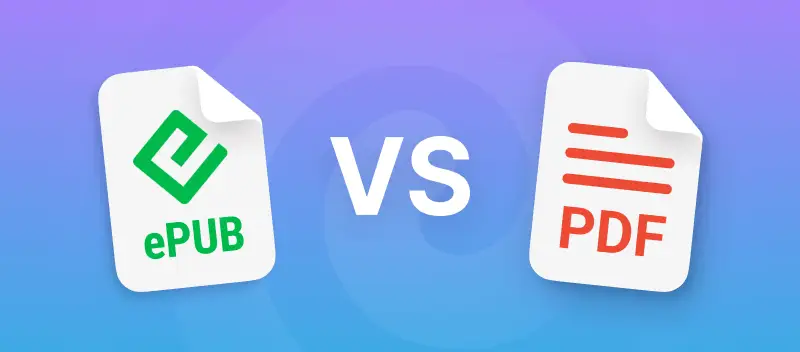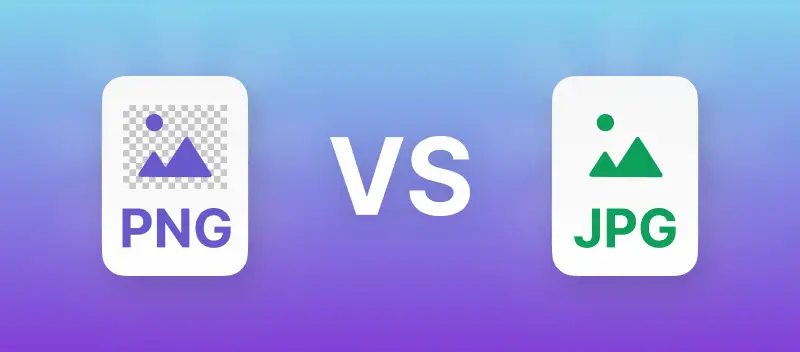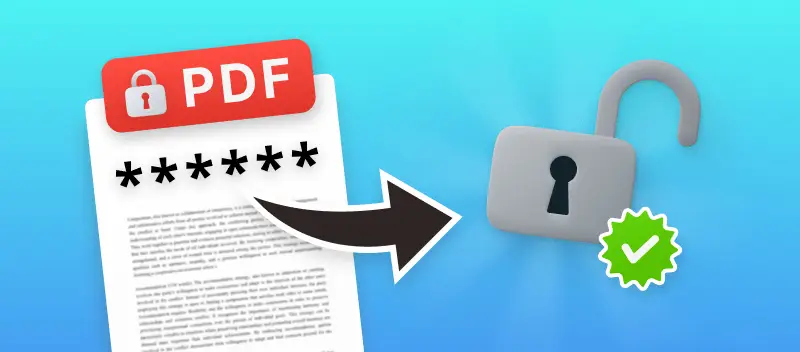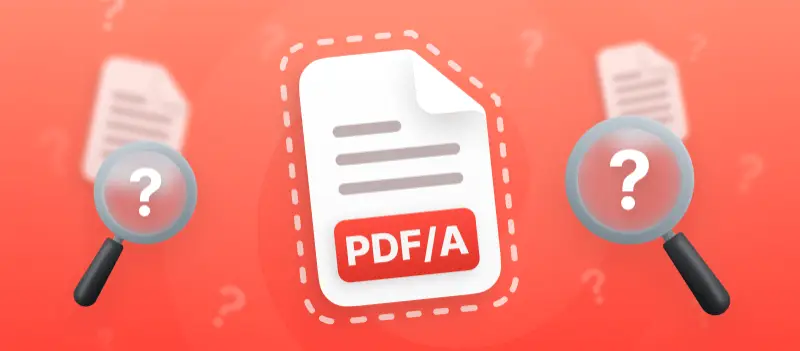As electronic books are becoming increasingly popular, there’s often a discussion about which format is better.
In this article, we will look at the ePub vs PDF debate. Understanding the strengths and limitations of each format is crucial for authors, publishers, and readers alike. This article explores the nuances of both.
What is ePub?
The ePub format is easy to spot with its .epub extension. It stands for electronic publication. Most often, this format is used for eBook storage.
This format is designed to be flexible and can adapt to various screen sizes, making it popular for e-readers, tablets, and smartphones. ePub files can contain text, images, and even multimedia elements. They support features like bookmarks, annotations, and text-to-speech functionality.
For these reasons, most e-reader devices support ePub files. This format allows for a more dynamic reading experience.
ePub format's main features:
- Integration of visuals. Allows for the inclusion of images alongside the text.
- Interactive elements. Supports the incorporation of hyperlinks, footnotes, and cross-references.
- Digital rights management. Provides tools for protecting copyrighted content.
- Compact file size. Files are typically smaller, allowing for easier distribution and faster downloads.
- Compliance with open standards. Adheres to standards established by the International Digital Publishing Forum (IDPF), ensuring interoperability and long-term viability.
What is a PDF?
PDF stand for Portable Document Format. This format has been around since the 1990s. It was designed to be transferable between devices without formatting issues and visual changes.
PDF serves as a popular eBook format renowned for its steadfast fidelity to document layout and design. It preserves the original formatting of content, making it ideal for documents where precise presentation is crucial, such as manuals, reports, and academic texts.
If you're looking for a static reading experience, PDF is your go-to format. It offers little flexibility but ensures consistent viewing across devices and platforms.
PDF format's main features:
- Universal compatibility. Works across different devices, operating systems, and software applications.
- Print-friendly. Ensures documents appear the same when printed, with consistent layout and formatting.
- Security options. Supports encryption, password protection, and digital signatures to secure sensitive content.
- Multimedia embedding. Allows for the inclusion of images, audio, and video files within documents.
- Digital rights management. Allows authors and publishers to control access to and distribution of copyrighted content.
PDF vs ePub: What do they have in common?
Both PDFs and ePubs are highly compatible and are in an open-file format. This means that you can read them both on a variety of devices and platforms, so it doesn’t matter if you’re using Windows, Linux, or macOS.
These formats also work on e-readers and tablets including Kindles, iPads and Android tablets like Galaxy Tabs. What’s more, both PDFs and ePubs are interactive, which allows users to annotate their reading, add comments, etc.
Here's a table listing some popular apps that support reading and editing ePub and PDF formats:
| App | Supported Format | Features |
|---|---|---|
| Adobe Acrobat Reader | Reading, annotation, editing, form filling | |
| Adobe Digital Editions | ePub, PDF | Reading, library management, annotations |
| Apple Books | ePub, PDF | Reading, annotations, iCloud sync |
| Calibre | ePub, PDF | eBook management, conversion, editing |
| Google Play Books | ePub, PDF | Reading, annotations, cloud sync |
| LibreOffice | Editing, conversion, document creation | |
| Microsoft Edge (Windows) | ePub, PDF | Reading, annotations, PDF editing |
| Microsoft Word | Editing, conversion, document creation | |
| Scribus | Desktop publishing, layout design | |
| Sumatra PDF | ePub, PDF | Lightweight PDF and ePub reader |
| VitalSource Bookshelf | ePub, PDF | Reading, annotations, study tools |
These are just a small selection of apps. There are many more programs available for desktop and mobile platforms as well as online ePub and PDF editors and readers.
Can I convert ePub to PDF?
In case you decide that you'd rather have your eBook as a PDF file, you can always employ an ePub to PDF converter to change the format. For example, you can use the online platform PDF Candy.
See below the steps for converting ePub to PDF:
- Go to the ePub to PDF converter in your browser.
- Click the "Add file(s)" button to upload the eBook you want to convert.
- Optionally, adjust the settings according to your preferences, such as the page size and margins.
- Hit "Convert" to start the processing.
- Once the conversion is complete, you can download the file to your computer or continue to edit the PDF.
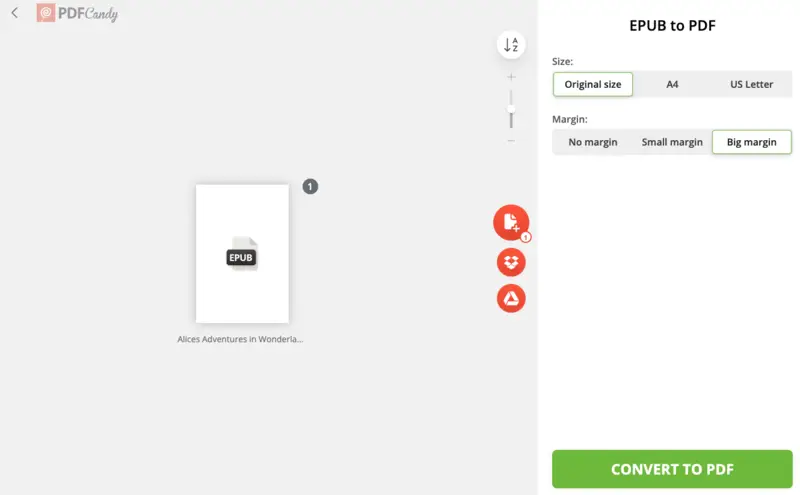
ePub vs PDF: Which One to Choose?
When it comes to digital documents, the choice between ePub and PDF formats often depends on specific needs and preferences.
| Feature | ePub | |
|---|---|---|
| Text Reflow | Yes | No |
| Multimedia Support | Limited | Extensive |
| Fixed Layout | No | Yes |
| Annotations | Yes | Yes |
| Compatibility | E-readers, tablets, smartphones, and PCs | Wide range of devices and platforms |
| File Size | Smaller | Larger |
| Security | Limited (depends on DRM) | Strong (supports encryption, passwords) |
| Printing | Limited | Excellent |
Pick ePub if you look for features such as flexibility and reflowable content, enhancing readability across various screens.
Alternatively, opt for PDF if you require precise layout control or compatibility with forms and professional documents.
FAQ
Which format is better for reading on e-readers?
For Kindle or Nook, ePub format is generally preferred. E-readers are optimized for adjustable text layout, a feature that ePub excels in, allowing for seamless reading experiences across different screen sizes and orientations.
Are PDF files compatible with all e-reader devices?
PDF files are compatible with most e-reader devices. However, the reading experience may vary depending on the device's capabilities and screen size. Some e-readers may offer better support for PDF files than others, so it's advisable to check the device specifications before purchasing.
Which one - ePub or PDF is better for users with visual impairments?
ePub format is typically better for visually impaired users due to its support for accessibility features like text-to-speech functionality and customizable font sizes. PDFs, on the other hand, may present challenges for those with visual impairments due to their fixed layout and limited accessibility options.
Are there iPhone apps to read ePub eBooks?
Yes, there are several iPhone apps available for reading ePub eBooks, such as Apple Books, Marvin Reader, and Adobe Digital Editions. These apps offer various features like customizable font settings, annotations, and synchronization across devices for a personalized reading experience.
What other eBook format I should consider?
Another format worth considering is AZW (Amazon Kindle Format). It is based on the MOBI format but includes additional features such as support for Amazon's proprietary DRM (Digital Rights Management). If you're publishing exclusively on Amazon or targeting Kindle users, AZW could be a suitable choice.
What is Digital Right Management?
DRM refers to measures used to protect digital content from unauthorized copying, distribution, and modification. It involves encryption and licensing to control access and enforce usage restrictions, aiming to safeguard creators' rights and deter piracy.
What are the limitations of DRM for eBooks?
DRM imposes restrictions on users' ability to share, transfer, and modify content. It can hinder interoperability between devices and platforms, limiting the flexibility of eBook usage. Additionally, DRM systems can be vulnerable to circumvention, potentially compromising the effectiveness of content protection measures.
Conclusion
It’s clear to see why both ePub and PDF are popular formats for files like eBooks. When comparing ePub vs PDF, if universality is what you need, PDF is the format to go for.
Many devices can view and open PDFs and the document will always look like the original, which is often important. Also, if you want to share documents that can’t be modified, PDFs are the best choice.
In many cases, you might need to change an ePub file to a versatile PDF, and there’s a simple solution to do so. We have a free online ePub to PDF converter, which doesn't watermark your files and keeps them secure according to the Privacy Policy.
Other tools you may find useful:
- If your created file turns out to be too large - shrink its size right away with the "Compress PDF" tool.
- Add a watermark to the PDF to protect the copyrights of your documents.
